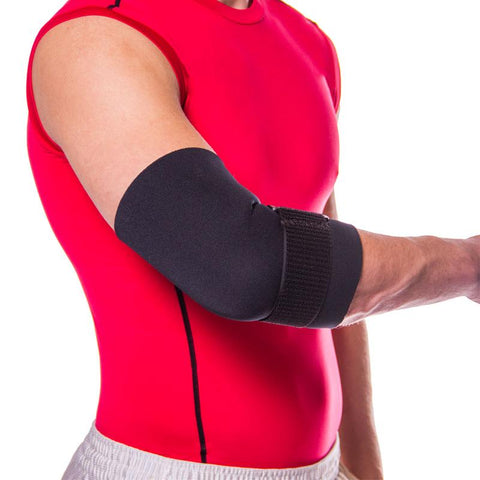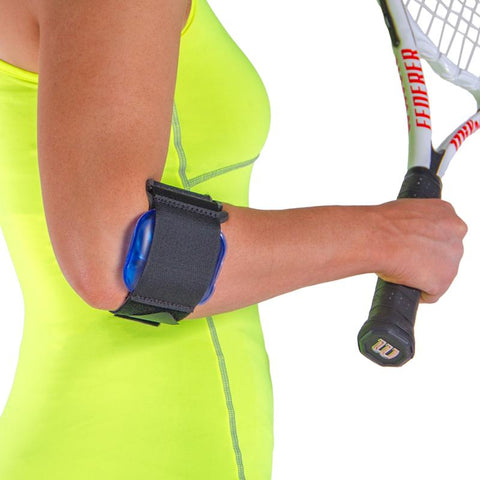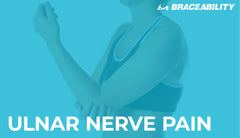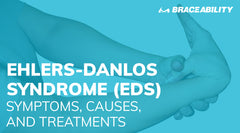Tennis Elbow (Lateral Epicondylitis)
What Is Tennis Elbow (Lateral Epicondylitis)?
Tennis elbow is a condition that causes lateral elbow pain. More specifically, the pain is usually in the lateral epicondyle elbow area—the bony knob at the outside of the elbow where the tendon attaches it to the muscles of the forearm (see the tennis elbow pictures below for a visual). For this reason, this condition is also known as lateral epicondylitis.
In the article that follows you will learn more about tennis elbow symptoms and treatment options. BraceAbility offers a number of orthotics for tennis elbow support, including sleeves, straps, and braces for treatment of tennis elbow.

What Causes Tennis Elbow?
Before delving into how to fix tennis elbow, it is worth discussing how it gets started in the first place; this can help when it comes to preventing a recurrence. The cause of tennis elbow, generally speaking, is overuse or overworking the tendons of the elbow. This is typically the result of repetitive motions of the wrist and arm. Such motions can cause tiny tears and inflammation of the tendon and, ultimately, tennis elbow pain.
What sort of activities or motions are causes of tennis elbow? While a common assumption might be that tennis arm stems from tennis, this sport is actually responsible for just a small number of incidences of lateral epicondyle pain—less than 5%, according to WebMD.
Sports, especially those involving rackets, can lead to a tennis elbow diagnosis. (Check out BraceAbility’s full line of tennis supports.) But more often, tennis elbow causes are the repetitive motions one performs on the job or at home. Some professions that might increase one’s risk of acute or chronic tennis elbow include:
- Carpenters
- Plumbers
- Butchers
- Painters
- Cooks
- Autoworkers
Most people in need of tennis elbow treatment are between the ages of 30 and 50 and it typically occurs in one’s dominant arm. Symptoms for tennis elbow are more common among men than women.
Tennis Elbow Symptoms
The first signs of tennis elbow are pain at the outside of the elbow that may radiate into the forearm and wrist, along with weakness in these areas. These symptoms of tennis elbow may make it difficult to squeeze something, stabilize the wrist or move the wrist forcefully. The symptoms typically worsen when doing such activities. This can make it difficult to do things such as:
- Brush one’s teeth
- Open jars
- Shake hands
- Turn a door knob
- Lift things
- Hold a coffee cup
How to Treat Tennis Elbow: First Steps
Before making the trip to the doctor, one should first try some home remedies for tennis elbow, including rest, ice, compression and the use of over-the-counter painkillers. These steps can help reduce painful inflammation and provide tennis elbow pain relief. Ultimately, these can help with healing tennis elbow damage.
If these methods do not bring tennis elbow relief, it may be time seek professional help on how to cure tennis elbow.
Lateral Epicondylitis Treatment: Tennis Elbow Exercises and Stretches
The next steps if the aforementioned ones fail to bring relief for tennis elbow are to engage in physical therapy for tennis elbow and possibly wear a tennis elbow brace or splint to limit stress on the injured tissue.
Therapy will involve exercises for tennis elbow and tennis elbow stretches that one should perform at therapy as well as at home. Engaging in such exercise for tennis elbow can strengthen and improve the flexibility of the forearm muscles and tendons so that they are better able to withstand repetitive stresses.
In addition, therapy for tennis elbow typically includes some education as to behavior and form alterations that reduce stress on the lateral epicondylitis (tennis elbow) area of the arm.
How to Relieve Tennis Elbow with Orthotics
Limiting stress on one’s soft tissues is also the aim of wearing a tennis elbow strap or tennis elbow sleeve. According to popularity, our Elbow Support Sleeve is the best tennis elbow brace. What makes this the best brace for tennis elbow (or at least a favorite)?
The tennis elbow remedy provides targeted compression that can relieve pain and prevent symptoms from worsening. And the breathable, anatomic fit of the sleeve is comfortable against the skin.
Another popular product that works for both medial and lateral epicondylitis is the Lateral & Medial Epicondylitis Treatment Elbow Brace.
Medial epicondylitis is also referred to by the sport with which it is associated—golf. Like tennis elbow, golfers’ elbow can stem from any number of activities that stress the tendons at this juncture. Indeed, one can even get tennis elbow from playing golf. The difference between tennis and golf elbow is that tennis elbow occurs on the outer, bony area of the elbow while golf elbow occurs on the inner part of the elbow. See golfers’ elbow supports here.
The medial or lateral epicondylitis strap is able to treat either condition thanks to the adjustable nature of its stabilo band. Also helping to make this one of BraceAbility’s most popular tennis elbow treatments is its two silicone pads that provide a gentle massage. These elements work together help to lower one’s tennis elbow recovery time.
Another unique option that pairs several elements of the steps for the best treatment for tennis elbow is the Tennis Elbow Cold Therapy Gel Compression Strap. This affordable remedy for tennis elbow has air and gel compression packs that simplify the process of using a tennis elbow ice pack. The air component of this support for tennis elbow applies compression therapy, which is also recommended as part of the steps on how to heal tennis elbow. See more hot, cold and compression therapy products.
Alternative Methods for Tennis Elbow Rehab
Some other potential cures for tennis elbow outside of the more traditional approach of engaging in tennis elbow physical therapy, wearing a brace or partaking in RICE home treatment for tennis elbow include receiving a corticosteroid injection and receiving acupuncture for tennis elbow.
A lateral epicondylitis injection can relieve pain, but its effects are temporary and extended use can cause more damage than good. For this reason, it is only pursued once more traditional remedies for tennis elbow have failed.
Another method that has been helpful for some dealing with severe tennis elbow is acupuncture. This practice is based on the idea that illness and pain occur when something blocks or causes an imbalance with the body’s energy (chi). Tennis elbow acupuncture, or sticking thin needles into the skin at certain points to influence energy flow, is thought to help improve such imbalances or blocks, thereby easing pain.
Tennis Elbow Surgery
In some cases, traditional tennis elbow cures fail and one must undergo surgery for tennis elbow. Such procedures typically involve the removal of damaged tissue and reattaching the healthy muscle back to the bone. But again, surgery tennis elbow treatment is typically only pursued when more traditional treatments for tennis elbow have failed and the condition has persisted for the better part of the year since all surgery involves risk.
Following surgery, one will likely need to immobilize the arm for around a week. Thereafter, one will have a regimen of tennis elbow treatment exercises to follow that will help restore range of motion and strength to the arm and elbow.






